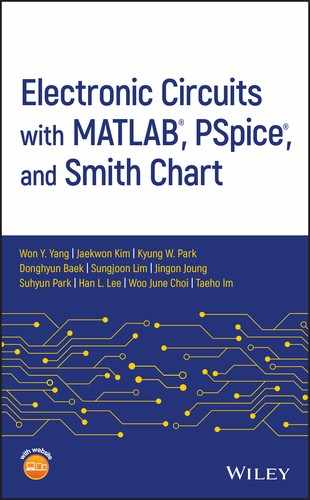Book Description
Provides practical examples of circuit design and analysis using PSpice, MATLAB, and the Smith Chart
This book presents the three technologies used to deal with electronic circuits: MATLAB, PSpice, and Smith chart. It gives students, researchers, and practicing engineers the necessary design and modelling tools for validating electronic design concepts involving bipolar junction transistors (BJTs), field-effect transistors (FET), OP Amp circuits, and analog filters.
Electronic Circuits with MATLAB®, PSpice®, and Smith Chart presents analytical solutions with the results of MATLAB analysis and PSpice simulation. This gives the reader information about the state of the art and confidence in the legitimacy of the solution, as long as the solutions obtained by using the two software tools agree with each other. For representative examples of impedance matching and filter design, the solution using MATLAB and Smith chart (Smith V4.1) are presented for comparison and crosscheck. This approach is expected to give the reader confidence in, and a deeper understanding of, the solution. In addition, this text:
- Increases the reader's understanding of the underlying processes and related equations for the design and analysis of circuits
- Provides a stepping stone to RF (radio frequency) circuit design by demonstrating how MATLAB can be used for the design and implementation of microstrip filters
- Features two chapters dedicated to the application of Smith charts and two-port network theory
Electronic Circuits with MATLAB®, PSpice®, and Smith Chart will be of great benefit to practicing engineers and graduate students interested in circuit theory and RF circuits.
Table of Contents
- Cover
- Preface
- About the Companion Website
- 1 Load Line Analysis and Fourier Series
- 2 Diode Circuits
- 3 BJT Circuits
- 4 FET Circuits
- 5 OP Amp Circuits
- 6 Analog Filter
- 7 Smith Chart and Impedance Matching
- 8 Two‐Port Network and Parameters
- Appendix A: Laplace TransformLaplace Transform
- Appendix B: Matrix Operations with MATLABMatrix Operations with MATLAB
- Appendix C: Complex Number Operations with MATLABComplex Number Operations with MATLAB
- Appendix D: Nonlinear/Differential Equations with MATLABNonlinear/Differential Equations with MATLAB
- Appendix E: Symbolic Computations with MATLABSymbolic Computations with MATLAB
- Appendix F: Useful FormulasUseful Formulas
- Appendix G: Standard Values of Resistors, Capacitors, and InductorsStandard Values of Resistors, Capacitors, and Inductors
- Appendix H: OrCAD/PSpice®OrCAD/PSpice®
- Appendix I: MATLAB® IntroductionMATLAB® Introduction
- Appendix J: Diode/BJT/FETDiode/BJT/FET
- Bibliography
- Index
- End User License Agreement
